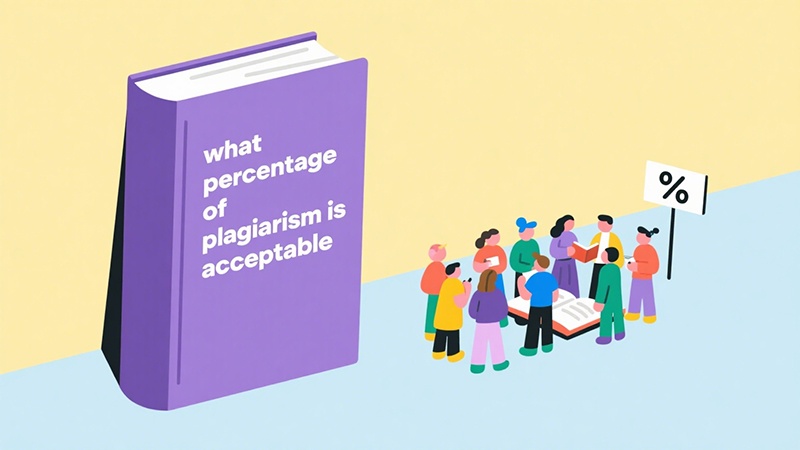What Percentage Is Considered Plagiarism? Comprehensive & Reliable
Plagiarism is a serious academic offense that can have significant consequences, including failing grades, academic probation, or even expulsion. With the widespread use of plagiarism detection tools like Turnitin, students and researchers often wonder: What percentage of plagiarism is acceptable?
While there's no universal standard, understanding how plagiarism is measured and what thresholds are considered acceptable in different academic contexts can help you stay on the right side of academic integrity.
Understanding Your Turnitin Plagiarism Percentage

Turnitin is one of the most widely used plagiarism detection tools in education. It generates a similarity report that shows what percentage of a submitted document matches existing sources in its database.Here's how to interpret the percentages:
-
0% - 10%: Generally considered safe. Minor matches like references, common phrases, or properly cited quotes.
-
11% - 24%: May be acceptable depending on the institution and how well the sources are cited. Review to ensure proper attribution.
-
25% - 49%: Raises red flags. Indicates a significant amount of overlapping content, even if cited.
-
50% and above: High risk. Suggests excessive copying or lack of original work.
Tips:
Turnitin does not detect plagiarism, it detects similarity. It's up to the instructor to determine if that similarity is plagiarism.
What Percentage Is Considered Plagiarism on Turntin?
When it comes to academic writing, universities and colleges take plagiarism very seriously. However, the acceptable percentage of similarity (as detected by plagiarism checkers like Turnitin) can vary depending on the institution, the level of study, and the type of assignment. While there's no universally fixed number, most institutions provide internal guidelines to help students understand what's considered acceptable.
Undergraduate Level (Bachelor's Degree)
For undergraduate students, most universities consider a similarity score of less than 10 - 15% to be acceptable. At this level, students are still learning how to research, paraphrase, and cite properly.
A modest similarity score often reflects the use of:
-
Common field-specific terminology.
-
Properly cited direct quotations.
-
Standard references or bibliographies, which are sometimes flagged by plagiarism checkers but are not viewed as misconduct.
Postgraduate / Research Level (Master's & PhD)
At the postgraduate level, expectations are significantly higher. Most universities recommend a similarity score under 10%, and in some cases, even under 5%.
Why stricter standards?
-
At this level, students are expected to contribute original ideas and demonstrate advanced critical thinking.
-
Heavy reliance on source material, even if cited, may indicate a lack of independent analysis.
Theses & Dissertations
For final research projects such as honors theses, master's theses, or PhD dissertations, the standards are the most stringent. Most institutions expect a similarity score of less than 5 - 10%, with a strong emphasis on originality.
Why so strict?
-
These works are considered significant contributions to academic knowledge.
-
They are often published or archived, making academic integrity critical.
-
A high similarity rate can undermine the credibility of the research and may lead to delays in approval or even rejection.
Tips:
Many universities allow students to exclude bibliographies and quoted materials from the similarity report to get a more accurate picture of originality.
How to Solve the Problem of High Plagiarism Scores?
1. Leverage Tenorshare AI Bypass
To address high similarity scores, especially for AI-generated content, use Tenorshare AI Bypass to humanize text. This tool rephrases AI-generated content to mimic human writing styles, reducing the AI detection rate and minimizing the risk of being flagged by tools like Scribbr, GPTZero, or Copyleaks.
2. Review the Similarity Report
Examine Turnitin's highlighted sections to identify matched text. Check if matches are from properly cited sources or unintentional overlap.
3. Use Plagiarism Checkers Early
Run drafts through tools like Turnitin, Grammarly, or Scribbr before submission to catch issues early.
4. Paraphrase Effectively
Rewrite matched sections in your own words while maintaining the original meaning. Ensure you still cite the source if the idea isn't yours.
5. Improve Citation Practices
Use proper citation formats (e.g., APA, MLA) for all quotes and ideas. Double-check that all sources are referenced.
6. Reduce Over-Quoting
Limit direct quotes and focus on synthesizing information in your own words to demonstrate understanding.
7. Seek Feedback
Consult instructors or writing centers to clarify citation rules or refine your work.
Conclusion
In today's academic environment, maintaining originality is essential. While minor similarities are sometimes unavoidable, excessive overlap can undermine your work and lead to serious consequences. Tools like Tenorshare AI Bypass can assist in refining AI-generated or highly similar content, helping to humanize writing and reduce detection risks. By combining proper citation, effective paraphrasing, and smart tools, you can uphold strong academic integrity.

Tenorshare AI Bypass
- Create 100% undetectable human-like content
- Bypass all AI detector tools like GPTZero, ZeroGPT, Copyleaks, etc.
- Original content, free of plagiarism and grammatical errors
- One-click AI bypass with a clean and easy-to-use interface
FAQs
1. What percentage of plagiarism is acceptable in university?
Acceptable plagiarism (or similarity) percentages vary by institution, but general guidelines are:
-
Undergraduate level: Less than 10 - 15%
-
Postgraduate level: Ideally under 10%
-
Theses/dissertations: Preferably under 5 - 10%
2. What is a good plagiarism percentage?
A "good" or safe plagiarism percentage is usually:
-
Below 10 - 15% for most assignments.
-
Below 5 - 10% for research papers, theses, or journal submissions.
3. What is considered a moderate plagiarism percentage?
A moderate similarity percentage typically falls between 15 - 25%. This range may be acceptable in some cases but often requires review. If the matched content is properly cited and non-critical, it may pass. However, anything above 25% usually needs revision.
4. What is the average plagiarism level?
There's no universal "average", but based on academic standards:
-
Most students aim for under 15%.
-
Research-level work often averages under 10%.
-
Anything above 20% is generally considered high and may be flagged for academic review.
5. Is a 30% Turnitin score acceptable?
A 30% score is usually considered too high. It may indicate excessive copying or weak paraphrasing, even if some matches are properly cited. Review and revise to improve originality.
You Might Also Like
- PapersOwl Plagiarism Checker Reviewed: Should You Trust It?
- How to Avoid Plagiarism in 2026: Top 5 Strategies for Ethical Writing
- Is Using ChatGPT Plagiarism?
- 8 Best Plagiarism Checker For Free: Pick the Suitable One
- Scribbr Plagiarism Checker 2026 Review
- Turnitin Plagiarism Checker Review: Features, Pros, Cons, Accuracy
